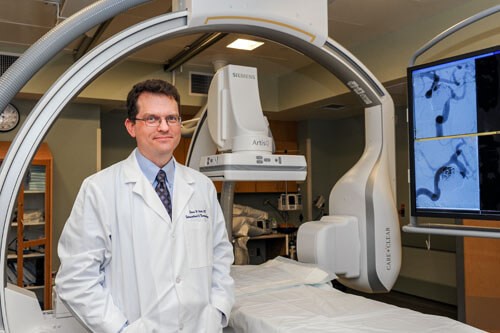UCSF, UC Berkeley and 3D Printer Carbon, Inc. Team Up to Create a Drug Sponge to Absorb Excess Chemotherapy Medication

We know that many anticancer drugs are poisonous, leaving doctors with the careful task of administering enough chemotherapy to stop the growth of cancer cells while minimizing any damage to a patient's other organs. Steven Hetts, MD is the chief of Interventional Neuroradiology at UCSF Mission Bay Hospitals. There, he provides cutting-edge, minimally invasive endovascular therapy for children and adults with stroke, cerebrovascular disease and tumors, including retinoblastoma. In treating these tumors of the eye and brain, he threads catheters through the bloodstream to deliver chemotherapy directly to the tumor, delivering the maximum dosage to the tumor and the least amount possible to the rest of the body. However, the injected dose can still escape the target organ and go into the body.
As a result, a few years ago, Dr. Hetts began thinking about the idea of a Chemofilter, a way to remove excess chemotherapy from the blood when treating tumors. After the chemotherapy has gone through the tumor, the part that hasn't treated the tumor would bind to the device, which would absorb the excess dose like a "drug sponge." At the end of the procedure, the device is removed from the body, preventing the spread of toxicity throughout. He and his team decided to focus on liver cancer, a deadly form of cancer that affects 40,000 Americans each year. With this concept in mind, it was time to get to work creating and testing a prototype.
To help make this happen, Dr. Hetts' team reached out to local professors. Nitash Balsara, professor of Chemical and Biomolecular Engineering at the University of California, Berkeley and a faculty scientist at Lawrence Berkeley National Laboratory "was actually crazy enough to return my email with interest," Anand Patel, former trainee in Dr. Hetts' lab (and now a Los Angeles-based interventional radiologist), told ScienceNews. Balsara is a chemical engineer who specializes in ionic polymers for battery and fuel cells. His team took a chemical engineering concept from petroleum refining and applied it to chemotherapy.
Balsara's lab got to work creating a commercial version of an absorbent polymer that would be "easier to obtain in large quantities," but can also be scaled as necessary to fit an individual's veins, based on information from Berkeley News. This effort was made possible by a partnership with Carbon, Inc., a Bay Area-based 3D printing company, to create the drug sponge - a 30-millimeter-long, cylinder-shaped object with an internal lattice structure - and the work of UC Berkeley's Hee Jeung Oh to find a way to adhere the polymer and the sponge so that the device could then be inserted into the vein.
Experiments were conducted to test the effectiveness of the device in absorbing the excess chemotherapy drug. Researchers found that about 64% of the drug was removed. The results were published online in ACS Central Science, a publication of the American Chemical Society. Next steps will be further testing, pending FDA approval. Dr. Hetts believes that this drug sponge concept can be applied to other types of tumors and chemotherapy drugs along with other drugs such as high-powered antibiotics that are used to kill pathogens but can harm kidneys.
The work was supported by a grant from the National Institutes of Health. Other coauthors are Mariam Aboian, MD, PhD, Mark Wilson, MD, Terilyn Moore and Colin Yee of UCSF Radiology; Michael Yi, Jacqueline Maslyn and Whitney Loo of UC Berkeley; Xi Jiang and Dilworth Parkinson, PhD of Lawrence Berkeley National Laboratory; and Joseph DeSimone, Gregory Robbins and Florian Barth of Carbon, Inc.
